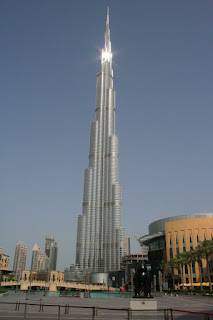Part two of five installments
Among the interesting aspects of my visit to Dubai was observing how the old and the new interact symbiotically as well as how they continue to conflict with each other.
 |
| A small section of Dubai Mall |
In the West, we pay little attention to the placement of stores, either in town squares or shopping malls but in the Middle East, souks were arranged by what they sold. Souks selling women’s clothing were located near others with the same type of merchandise. Likewise, men’s clothing purveyors were clustered together, fish mongers were next to each other, vegetable and fruit producers were near others selling the same type of merchandise.
In many ways, it made sense. If a person needed food, they would need only go to a specific area rather than heading out hither and yon. And “hither and yon” is a lot tougher on foot or camel-back than in a mini-van or SUV.
Today, many of the area’s shopping malls are arranged similarly. While not as strict as in the days of the souks, Dubai Mall, the Mall of the Emirates and indeed the city itself are, to a great degree, arranged by the types of goods or services they sell.
 |
| The Burj Khalifa |
When contrasting the old and the new, it is interesting that Dubai officially courts something that might have been frowned upon in the past: Hollywood and its movies. Dubai has been the setting for scenes in several movies, including “Mission Impossible: Ghost Protocol,” in which Tom Cruise’s character Ethan Hunt climbs the outside of the 160-story Burj Khalifa. “Fast and Furious 7” includes scenes filmed in Dubai, Abu Dhabi and elsewhere in the U.A.E.
The city will host its 13th annual International Film Festival in December, an “[A]nnual platform for Arab film-makers and talent, as well as for showcasing the emerging cinema movement,” according to the festival’s website. Although its stated focus is on Arab filmmakers, Western actors including Catherine Deneuve, Jake Gyllenhaal and Emily Blount have been honored and awarded at past festivals.
 |
| Identifying the "no man" zone on the Metro. |
Consumption of alcohol is another area where the old and the new have not been fully reconciled. Unlike many – if not most – Western countries where alcohol is ubiquitous, it is more difficult to find in Dubai.
A misconception I heard repeated quite often is that only large hotels can get licenses to buy and serve liquor. While not entirely accurate, it is true that licensed establishments are rare outside hotels that cater to Western guests. As a result, at many large chain restaurants like Chili’s where diners are accustomed to grabbing a beer to wash down their tacos and burritos, they must make do with soft drinks.
Some rare independent establishments such as the noted Mediterranean restaurant Qbara where I enjoyed dinner with a couple I had met in Emirates’ premium lounge at LAX have permits to serve beer, wine and spirits, and these usually identify themselves by using the word “bar” in their name, such as “restaurant, lounge and bar.”
When dining out, it will be useful to understand that tipping is customary in Dubai but there is a caveat: Tips – including, in some cases, the “service charge” or “fee” added to restaurant bills – don’t always go to the person providing the service. A visitor who wants to reward good service directly should ask the staff if they receive the tips and, if not, slip them cash discreetly. Guests can also ask to have the automatic service fee removed from the bill.
On a related note, weekends in the U.A.E. are Friday and Saturday, and Friday brunches are a very popular activity, much as Sunday brunches are in the U.S.
An astute observer might see some apparent incongruities where tradition and progress intersect. While many men wore traditional Arabic garb including the white, flowing robes called jubba and a head scarf called a keffiyeh secured by two black ropes called agal, many also carried smartphones and iPads.
 |
| McDonald's along Sheikh Zayed Road |
The fingers that clutched designer handbags had been carefully manicured and, though fingernails remained their natural color, the toes showing through the sandals were clearly sporting the latest color in polish.
While traditional garb can be seen most everywhere, Dubai is clearly a multi-cultural city with residents and visitors alike sporting clothing from across virtually all cultures.
Recommendations for getting around this bustling, multi-cultural city in my next installment.
Visit my main page at TheTravelPro.us for more news, reviews, and personal observations on the world of upmarket travel.
Follow @TheTravelProUS
Photos by Carl Dombek
Click on photos to view larger images
Comments
Post a Comment
PLEASE NOTE:Comments on this website must pertain to the topic of the article and may be edited for content and/or clarity. Comments that include URLs WILL NOT BE POSTED. Please contact me directly if you wish to do a "link exchange."